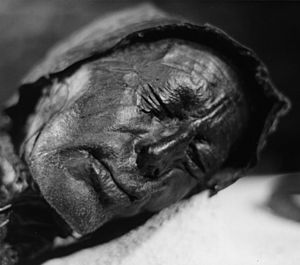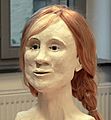Bog body facts for kids

A bog body is a human body found in a peat bog. These bodies are naturally preserved by the bog. People sometimes call them bog people. They have been found all over the world. Some are as old as BC/BCE, and some are from as recently as World War II. What makes them 'bog bodies' is that they were found in peat. They are all partly preserved. Some look almost perfect, while others are just skeletons.
Unlike most ancient human remains, bog bodies often still have their skin and internal organs. This happens because of the special conditions in the bog. The water is very acidic, the temperature is low, and there is little oxygen. These conditions preserve the skin, but they also make it look very tan. While the skin stays well-preserved, the bones usually do not. The acidic bog water helps to preserve things like skin, hair, nails, wool, and leather.
The oldest known bog body is the skeleton of Koelbjerg Man from Denmark. He lived around 8000 BCE, during the Mesolithic period. The oldest bog body that still has flesh is Cashel Man. He lived around 2000 BCE, during the Bronze Age. Most bog bodies, like Tollund Man, Grauballe Man, and Lindow Man, are from the Iron Age. They have been found mostly in northwest Europe. This includes countries like Denmark, Germany, the Netherlands, the UK, Sweden, Poland, and Ireland.
Iron Age bog bodies often share some similarities. Many show signs of violent deaths. They also often have little or no clothing. This has made archaeologists think they were placed in bogs as part of old traditions. These traditions might have included special ceremonies or punishments for criminals. Bogs might have been seen as special places connected to another world. Some newer ideas suggest that bog people were seen as outsiders. They might have been victims of unusual deaths.
About 122 bog bodies have been found and studied. The newest bog bodies are soldiers found in wetlands from World War II.
Famous Bog Bodies
Many bog bodies have been found and studied. Most of them come from countries in Northern Europe. These include Denmark, Germany, the Netherlands, the United Kingdom, and Ireland. In 1965, a German scientist named Alfred Dieck listed over 1,850 bog bodies. But later research showed that many of his findings were not correct. So, we don't know the exact number of bodies found.
Several bog bodies are very famous. This is because they are so well-preserved. Also, archaeologists and scientists have learned a lot from them. Here are some notable examples:
- Bocksten Man: This body is from 1290 to 1430 CE. It was found in 1936 in Varberg, Sweden.
- Borremose Bodies: These bodies are from 400–700 BCE. They were found in the 1940s in Himmerland, Denmark.
- Cashel Man: This body is from 2000 BCE. It was found in 2011 in County Laois, Ireland. It is the oldest bog body with flesh still on it.
- Cladh Hallan mummies: These are from 1600 to 1300 BCE. They were found on the island of South Uist, Scotland.
- Clonycavan Man: This body is from 392–201 BCE. It was found in 2003 in County Meath, Ireland.
- Girl of the Uchter Moor: This body is from between 764 and 515 BCE. It was found in 2000 in Uchte, Germany.
- Grauballe Man: This body is from 290 BCE. It was found in 1952 in Jutland, Denmark.
- Haraldskær Woman: This body is from 490 BCE. It was found in 1835 in Jutland, Denmark.
- Lindow Man: This body is from 2 BCE – 119 CE. It was found in 1984 in Cheshire, England.
- Old Croghan Man: This body is from 362–175 BCE. It was found in 2003 in County Offaly, Ireland.
- Tollund Man: This body is from 400 BCE. It was found in 1950 in Jutland, Denmark.
- Weerdinge Men: These bodies are from 160–220 BCE. They were found in 1904 in Drenthe, Netherlands.
- Windeby I: This body is from 41 BCE and 118 CE. It was found in 1952 in Schleswig-Holstein, Germany.
- Yde Girl: This body is from 170 BCE – 230 CE. It was found in 1897 near Yde, Netherlands.
Images for kids
-
Remains from Levänluhta (Isokyrö, Ostrobothnia) at the National Museum of Finland
See also
 In Spanish: Momia del pantano para niños
In Spanish: Momia del pantano para niños





